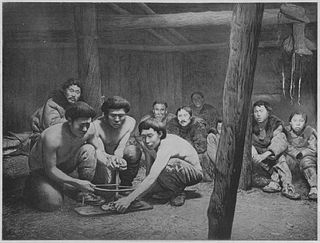
Koryaks are an Indigenous people of the Russian Far East, who live immediately north of the Kamchatka Peninsula in Kamchatka Krai and inhabit the coastlands of the Bering Sea. The cultural borders of the Koryaks include Tigilsk in the south and the Anadyr basin in the north.

The Eskaleut, Eskimo–Aleut or Inuit–Yupik–Unangan languages are a language family native to the northern portions of the North American continent, and a small part of northeastern Asia. Languages in the family are indigenous to parts of what are now the United States (Alaska); Canada including Nunavut, Northwest Territories, northern Quebec (Nunavik), and northern Labrador (Nunatsiavut); Greenland; and the Russian Far East. The language family is also known as Eskaleutian, or Eskaleutic.

Nivkh, or Gilyak, or Amuric, is a small language family, often portrayed as a language isolate, of two or three mutually unintelligible languages spoken by the Nivkh people in Russian Manchuria, in the basin of the Amgun, along the lower reaches of the Amur itself, and on the northern half of Sakhalin. "Gilyak" is the Russian rendering of terms derived from the Tungusic "Gileke" and Manchu-Chinese "Gilemi" for culturally similar peoples of the Amur River region, and was applied principally to the Nivkh in Western literature.
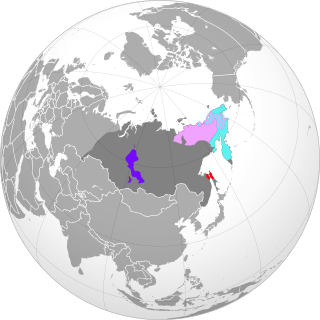
The Paleo-Siberian languages are several language isolates and small language families spoken in parts of Siberia. They are not known to have any genetic relationship to each other; their only common link is that they are held to have antedated the more dominant languages, particularly Tungusic and latterly Turkic languages, that have largely displaced them. Even more recently, Turkic and especially Tungusic have been displaced in their turn by Russian.

Chukchi, also known as Chukot, is a Chukotko–Kamchatkan language spoken by the Chukchi people in the easternmost extremity of Siberia, mainly in Chukotka Autonomous Okrug. The language is closely related to Koryak. Chukchi, Koryak, Kerek, Alutor, and Itelmen form the Chukotko-Kamchatkan language family. There are many cultural similarities between the Chukchis and Koryaks, including economies based on reindeer herding. Both peoples refer to themselves by the endonym Luorawetlat, meaning "the real people". All of these peoples and other unrelated minorities in and around Kamchatka are known collectively as Kamchadals.

The Chukotko-Kamchatkan or Chukchi–Kamchatkan languages are a language family of extreme northeastern Siberia. Its speakers traditionally were indigenous hunter-gatherers and reindeer-herders. Chukotko-Kamchatkan is endangered. The Kamchatkan branch is moribund, represented only by Western Itelmen, with less than a hundred speakers left. The Chukotkan branch had close to 7,000 speakers left, with a reported total ethnic population of 25,000.

Koryak is a Chukotko-Kamchatkan language spoken by 1,665 people as of 2010 in the easternmost extremity of Siberia, mainly in Koryak Okrug. It is mostly spoken by Koryaks. Its close relative, the Chukchi language, is spoken by about three times that number. The language together with Chukchi, Alyutor and Itelmen forms the Chukotko-Kamchatkan language family. Its native name in Koryak is нымылан nymylan, but variants of the Russian name "Koryak" are most commonly used in English and other languages.
Chulym, also known as Chulim, Chulym-Turkic and Ös, is a critically endangered language of the Chulyms. The names which the people use to refer to themselves are 1. пистиҥ кишилер, pistɪŋ kiʃɪler and 2. ось кишилер, øs kiʃɪler. The native designation for the language are ось тил(и), øs til(ɪ) ~ ø:s til(ɪ), and less frequently тадар тил(и), tadar til(ɪ).
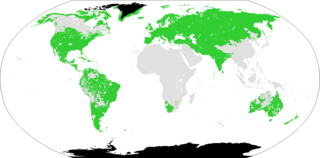
Eurasiatic is a hypothetical and controversial language macrofamily proposal that would include many language families historically spoken in northern, western, and southern Eurasia.
Kereks are an ethnic group of people in Russia. In the 2021 census, only 23 people registered as ethnic Kereks in Russia. According to the 2010 census, there were only 4, and according to the 2002 census, there were 8 people registered as Kereks. According to the 1897 census, there were still 102 Kereks. During the twentieth century, Kereks were almost completely assimilated into the Chukchi people.

Itelmen or Western Itelmen, formerly known as Western Kamchadal, is a language of the Chukotko-Kamchatkan family spoken on the western coast of the Kamchatka Peninsula. Fewer than a hundred native speakers, mostly elderly, in a few settlements in the southwest of Koryak Autonomous Okrug, remained in 1993. The 2021 Census counted 2,596 ethnic Itelmens, virtually all of whom are now monolingual in Russian. However, there are attempts to revive the language, and it is being taught in a number of schools in the region.
Geographically, Siberia includes the Russian Urals, Siberian, and Far Eastern Federal Districts.
The Alyutors are an ethnic group who live on the Kamchatka Peninsula and Chukchi Peninsula of the Russian Far East. Today most of them live in Koryak Okrug of Kamchatka Krai.

Chukotkan is a dialect cluster that forms one branch of the Chukotko-Kamchatkan language family. It is spoken in two autonomous regions at the extreme northeast of Russia, bounded on the east by the Pacific and on the north by the Arctic.

Kamchatkan (Kamchatic) is a former dialect cluster spoken on the Kamchatka Peninsula. It now consists of a single language, Western Itelmen. It had 100 or fewer speakers in 1991, mostly of the older generation. The Russian census of 2010 still reported 80 speakers.
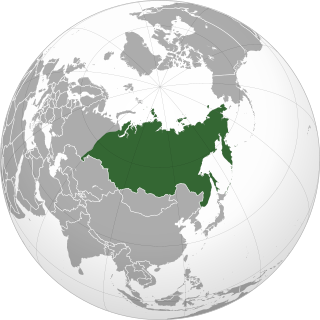
Siberia is a vast region spanning the northern part of the Asian continent and forming the Asiatic portion of Russia. As a result of the Russian conquest of Siberia and of the subsequent population movements during the Soviet era (1917–1991), the modern-day demographics of Siberia is dominated by ethnic Russians (Siberiaks) and other Slavs. However, there remains a slowly increasing number of Indigenous groups, accounting for about 5% of the total Siberian population, some of which are closely genetically related to Indigenous peoples of the Americas.

En with hook is a letter of the Cyrillic script. Its form is derived from the Cyrillic letter En (Н н) by adding a hook to the right leg.
Tolkusha is a traditional food of the Chukotko-Kamchatkan peoples in the Russian Far East, especially Kamchatka. It is made of dried fish meat or fish roe mixed with fat and berries extended with edible plant bulbs or stems, ground and pounded together for a long time to yield a white paste.
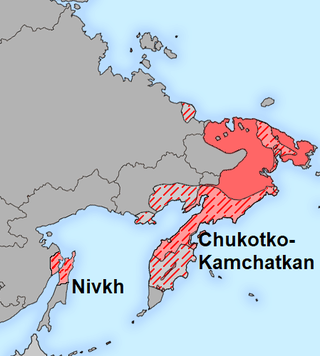
The Chukotko-Kamchatko-Amuric or Chukotko-Kamchatkan-Amuric languages form a hypothetical language family including Nivkh and Chukotko-Kamchatkan. A relationship between these two language groups was proposed by Michael Fortescue in a 2011 paper. He theorized that their common ancestor might have been spoken around 4000 years ago. However Glottolog says that the evidence is insufficient to conclude a genealogical relationship between Nivkh and Chukotko-Kamchatkan.
This article discusses the phonology of the Chukchi language. The Chukchi language, also known as Chukot or Luorawetlan, is a language spoken by around 5 thousand people in Chukotka Autonomous Okrug. The endonym of the Chukchi language is Ԓыгъоравэтԓьэн йиԓыйиԓ , pronounced as [ɬəɣˀorawetɬˀɛn jiɬəjiɬ]. Chukchi is in the Chukotko-Kamchatkan family, and thus is closely related to Koryak, Kerek, Alyutor, and more distantly related to Itelmen, Southern Kamchadal, and Eastern Kamchadal.











